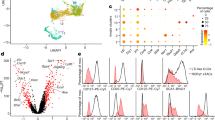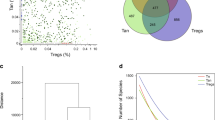Abstract
Peripheral mechanisms preventing autoimmunity and maintaining tolerance to commensal microbiota involve CD4+Foxp3+ regulatory T (Treg) cells1,2 generated in the thymus or extrathymically by induction of naive CD4+Foxp3− T cells. Previous studies suggested that the T-cell receptor repertoires of thymic Treg cells and induced Treg cells are biased towards self and non-self antigens, respectively3,4,5,6, but their relative contribution in controlling immunopathology, such as colitis and other untoward inflammatory responses triggered by different types of antigens, remains unresolved7. The intestine, and especially the colon, is a particularly suitable organ to study this question, given the variety of self-, microbiota- and food-derived antigens to which Treg cells and other T-cell populations are exposed. Intestinal environments can enhance conversion to a regulatory lineage8,9 and favour tolerogenic presentation of antigens to naive CD4+ T cells10,11, suggesting that intestinal homeostasis depends on microbiota-specific induced Treg cells12,13,14,15. Here, to identify the origin and antigen-specificity of intestinal Treg cells, we performed single-cell and high-throughput sequencing of the T-cell receptor repertoires of CD4+Foxp3+ and CD4+Foxp3− T cells, and analysed their reactivity against specific commensal species. We show that thymus-derived Treg cells constitute most Treg cells in all lymphoid and intestinal organs, including the colon, where their repertoire is heavily influenced by the composition of the microbiota. Our results suggest that thymic Treg cells, and not induced Treg cells, dominantly mediate tolerance to antigens produced by intestinal commensals.
This is a preview of subscription content, access via your institution
Access options
Subscribe to this journal
Receive 51 print issues and online access
$199.00 per year
only $3.90 per issue
Buy this article
- Purchase on Springer Link
- Instant access to full article PDF
Prices may be subject to local taxes which are calculated during checkout




Similar content being viewed by others
References
Belkaid, Y. & Rouse, B. T. Natural regulatory T cells in infectious disease. Nature Immunol. 6, 353–360 (2005)
Sakaguchi, S., Powrie, F. & Ransohoff, R. M. Re-establishing immunological self-tolerance in autoimmune disease. Nature Med. 18, 54–58 (2012)
Jordan, M. S. et al. Thymic selection of CD4+CD25+ regulatory T cells induced by an agonist self-peptide. Nature Immunol. 2, 301–306 (2001)
Ribot, J., Romagnoli, P. & van Meerwijk, J. P. Agonist ligands expressed by thymic epithelium enhance positive selection of regulatory T lymphocytes from precursors with a normally diverse TCR repertoire. J. Immunol. 177, 1101–1107 (2006)
Coutinho, A. et al. Thymic commitment of regulatory T cells is a pathway of TCR-dependent selection that isolates repertoires undergoing positive or negative selection. Curr. Top. Microbiol. Immunol. 293, 43–71 (2005)
Hsieh, C. S. et al. An intersection between the self-reactive regulatory and nonregulatory T cell receptor repertoires. Nature Immunol. 7, 401–410 (2006)
Curotto de Lafaille, M. A. & Lafaille, J. J. Natural and adaptive Foxp3+ regulatory T cells: more of the same or a division of labor? Immunity 30, 626–635 (2009)
Barnes, M. J. & Powrie, F. Regulatory T cells reinforce intestinal homeostasis. Immunity 31, 401–411 (2009)
Mucida, D. et al. Reciprocal TH17 and regulatory T cell differentiation mediated by retinoic acid. Science 317, 256–260 (2007)
Coombes, J. L. et al. A functionally specialized population of mucosal CD103+ DCs induces Foxp3+ regulatory T cells via a TGF-β and retinoic acid-dependent mechanism. J. Exp. Med. 204, 1757–1764 (2007)
Denning, T. L. et al. Lamina propria macrophages and dendritic cells differentially induce regulatory and interleukin 17-producing T cell responses. Nature Immunol. 8, 1086–1094 (2007)
Round, J. L. & Mazmanian, S. K. Inducible Foxp3+ regulatory T-cell development by a commensal bacterium of the intestinal microbiota. Proc. Natl Acad. Sci. USA 107, 12204–12209 (2010)
Atarashi, K. et al. Induction of colonic regulatory T cells by indigenous Clostridium species. Science 331, 337–341 (2011)
Lathrop, S. K. et al. Peripheral education of the immune system by colonic commensal microbiota. Nature 478, 250–254 (2011)
Haribhai, D. et al. A requisite role for induced regulatory T cells in tolerance based on expanding antigen receptor diversity. Immunity 35, 109–122 (2011)
Pacholczyk, R. et al. Origin and T cell receptor diversity of Foxp3+CD4+CD25+ T cells. Immunity 25, 249–259 (2006)
Kuczma, M. et al. Foxp3-deficient regulatory T cells do not revert into conventional effector CD4+ T cells but constitute a unique cell subset. J. Immunol. 183, 3731–3741 (2009)
Hsieh, C. S. et al. Recognition of the peripheral self by naturally arising CD25+ CD4+ T cell receptors. Immunity 21, 267–277 (2004)
Wong, J., Mathis, D. & Benoist, C. TCR-based lineage tracing: no evidence for conversion of conventional into regulatory T cells in response to a natural self-antigen in pancreatic islets. J. Exp. Med. 204, 2039–2045 (2007)
Lathrop, S. K. et al. Antigen-specific peripheral shaping of the natural regulatory T cell population. J. Exp. Med. 205, 3105–3117 (2008)
Kuczma, M. et al. Intratumoral convergence of the TCR repertoires of effector and Foxp3+ CD4+ T cells. PLoS ONE 5, e13623 (2010)
Pacholczyk, R. et al. Nonself-antigens are the cognate specificities of Foxp3+ regulatory T cells. Immunity 27, 493–504 (2007)
Bautista, J. L. et al. Intraclonal competition limits the fate determination of regulatory T cells in the thymus. Nature Immunol. 10, 610–617 (2009)
Suffia, I. J. et al. Infected site-restricted Foxp3+ natural regulatory T cells are specific for microbial antigens. J. Exp. Med. 203, 777–788 (2006)
Geuking, M. B. et al. Intestinal bacterial colonization induces mutualistic regulatory T cell responses. Immunity 34, 794–806 (2011)
Josefowicz, S. Z. et al. Extrathymically generated regulatory T cells control mucosal TH2 inflammation. Nature 482, 395–399 (2012)
Fahlén, L. et al. T cells that cannot respond to TGF-β escape control by CD4+CD25+ regulatory T cells. J. Exp. Med. 201, 737–746 (2005)
Rempala, G. A. & Seweryn, M. Methods for diversity and overlap analysis in T-cell receptor populations. J. Math. Biol. . http://dx.doi.org/10.1007/s00285-012-0589-7 (25 September 2012)
Singh, N. et al. Generation of T cell hybridomas from naturally occurring FoxP3+ regulatory T cells. Methods Mol. Biol. 707, 39–44 (2011)
Renyi, A. On measures of information and entropy. Proc. 4th Berkley Symp. Math. Stat. Prob. 1, 547–561 (1961)
Acknowledgements
This work was supported by basic research grants from the National Institutes of Health (NIH; AI 5R01AI079277 to L.I., and DMS1106485 and R01CA152158 to G.A.R.). The Harvard Digestive Disease Center (HDDC) Microbiome Core facility is supported by P30-DK034854 and Brigham and Women’s Hospital in Boston, Massachusetts. Microbiological analyses were performed by M. Delaney, A. Dubois and Q. Liu in the HDDC Microbiome Core, with additional review of findings by A. B. Onderdonk. We thank J. Pihkala and H. Ignatowicz for technical assistance, M. Kuczma, L. Wojciech, E. Szurek, A. Miazek and P. Muranski for discussion and R. Markowitz for editing the manuscript.
Author information
Authors and Affiliations
Contributions
A.C. performed most experiments and analysed the data; M.S. and G.A.R. performed statistical analyses; S.S.P. and R.A.M. designed the PACE program; T.L.D. provided expertise in colonic T-cell isolation; L.B. performed the microbiological study; P.Kr. established TCRmini and Foxp3GFP mice models; P.Ki. and L.I. designed the study, analysed the data and wrote the paper.
Corresponding author
Ethics declarations
Competing interests
The authors declare no competing financial interests.
Supplementary information
Supplementary Information
This file contains Supplementary Figures 1-7 and Supplementary Tables 1-6. (PDF 641 kb)
Rights and permissions
About this article
Cite this article
Cebula, A., Seweryn, M., Rempala, G. et al. Thymus-derived regulatory T cells contribute to tolerance to commensal microbiota. Nature 497, 258–262 (2013). https://doi.org/10.1038/nature12079
Received:
Accepted:
Published:
Issue Date:
DOI: https://doi.org/10.1038/nature12079
This article is cited by
-
Pathobionts from chemically disrupted gut microbiota induce insulin-dependent diabetes in mice
Microbiome (2023)
-
Complex regulatory effects of gut microbial short-chain fatty acids on immune tolerance and autoimmunity
Cellular & Molecular Immunology (2023)
-
Regulatory T cells in the face of the intestinal microbiota
Nature Reviews Immunology (2023)
-
Potential links between the microbiota and T cell immunity determine the tumor cell fate
Cell Death & Disease (2023)
-
Localization and movement of Tregs in gastrointestinal tract: a systematic review
Inflammation and Regeneration (2022)
Comments
By submitting a comment you agree to abide by our Terms and Community Guidelines. If you find something abusive or that does not comply with our terms or guidelines please flag it as inappropriate.



